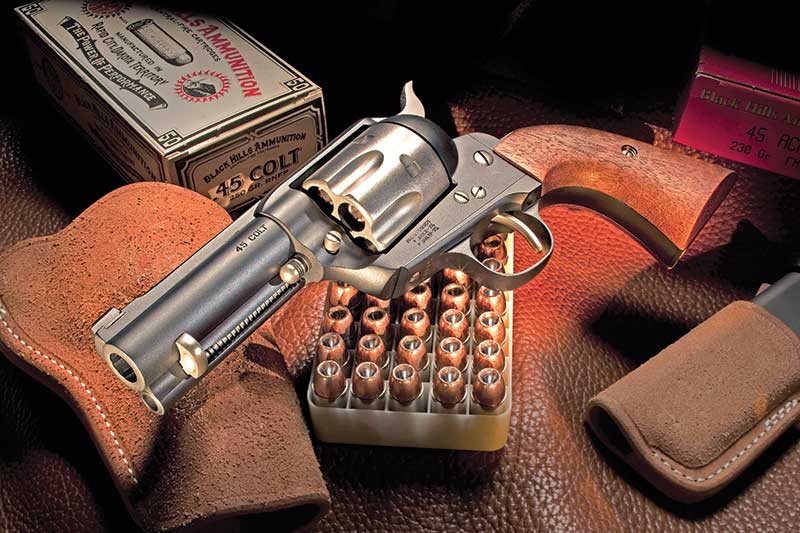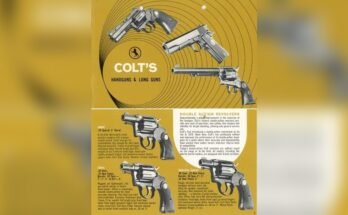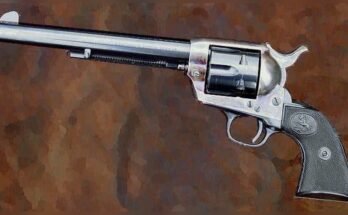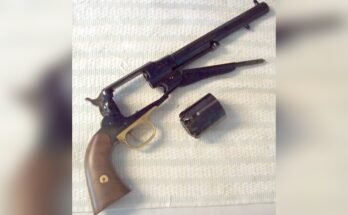If you’re considering a single-action revolver, you probably want to know one thing: how reliable is it really? After all, when it comes to firearms, trust can’t be an afterthought.
Whether you’re a collector, a shooter, or someone who values safety, understanding the reliability of these classic guns is key. You’ll discover what makes single-action revolvers tick, where they shine, and what potential issues you should watch out for. Keep reading, because knowing this could make all the difference in your next shooting experience.

History Of Single-action Revolvers
The history of single-action revolvers is rich and fascinating. These firearms shaped the way people thought about personal defense and hunting in the 19th century. They became symbols of the Old West and remain popular among collectors and shooters today.
Understanding their past helps us see why they are still reliable and valued. The story begins with early designs that introduced new ideas and technology. Over time, these revolvers evolved to meet the needs of users and improve safety and performance.
Early Designs And Innovations
The first single-action revolvers appeared in the early 1800s. Inventors worked to create a firearm that could hold multiple bullets. This allowed faster shooting without reloading after every shot.
One key innovation was the revolving cylinder. This part holds several cartridges and rotates with each cock of the hammer. It made shooting quicker and easier than with older pistols.
In 1836, Samuel Colt patented a design that became very popular. His revolver was strong, reliable, and easy to use. Many armies and civilians adopted Colt’s revolvers for protection and battle.
Evolution Over The Years
Single-action revolvers changed slowly over many decades. Makers improved the materials to make guns stronger and lighter. They also added features like better sights and grips for comfort.
The classic Colt Single Action Army, introduced in 1873, is a famous example. It became known as the “Peacemaker” and was widely used in the American West.
Even today, some manufacturers produce modern versions of these revolvers. They keep the old design but add new safety measures and stronger metals. This shows how the single-action revolver blends tradition with reliability.
Mechanics Behind Single-action Revolvers
Single-action revolvers rely on a simple but strong design. Their mechanics have stayed mostly the same for over a century. Understanding how these guns work helps explain their reliability and popularity.
The design uses a straightforward system of parts that work together. Each part has a clear job. This makes single-action revolvers easier to maintain and less likely to fail.
Trigger And Hammer Operation
The trigger on a single-action revolver does one main job: release the hammer. To fire, you must first pull back the hammer by hand. This action cocks the gun and prepares it to shoot.
When you pull the trigger, it lets the hammer fall forward. The hammer hits the firing pin, which ignites the bullet’s primer. This simple trigger and hammer setup reduces the chance of mechanical problems.
Cylinder Rotation And Locking
The cylinder holds the bullets in separate chambers. Each time you cock the hammer, the cylinder rotates. This movement aligns a fresh chamber with the barrel.
A locking mechanism keeps the cylinder in place during firing. This ensures the bullet travels straight down the barrel. The strong lock prevents misfires and keeps the gun safe to use.
Common Reliability Concerns
Single-action revolvers have a strong reputation for reliability, but some common concerns still come up. These concerns mainly focus on how often the gun might fail to fire or get stuck during use. Understanding these issues helps owners keep their revolvers in good shape and avoid problems in critical moments.
Misfires And Jams
Misfires happen when the gun does not fire after pulling the trigger. This can occur due to bad ammunition or a weak hammer strike. Single-action revolvers have fewer moving parts than other guns, so jams are rare but still possible. Dirt or debris can cause the cylinder to stick, leading to jams. Regular cleaning can prevent most misfires and jams.
Wear And Tear Factors
Wear and tear affect the revolver’s parts over time. The hammer, cylinder, and trigger are the most used parts. Constant use can cause these parts to become loose or worn out. Springs may weaken, causing slower or weaker hammer strikes. Proper maintenance and timely part replacement keep the revolver reliable for many years.
Comparing With Other Revolver Types
Single-action revolvers have a classic design and a simple firing process. They are often seen as reliable due to their fewer moving parts. Understanding how they compare to other revolvers helps to see their strengths and weaknesses.
Other revolver types include double-action revolvers and semi-automatic pistols. Each type offers a different experience in terms of speed, ease of use, and reliability.
Double-action Revolvers
Double-action revolvers allow the shooter to fire by simply pulling the trigger. This means the hammer does not need to be manually cocked first. This feature makes double-action revolvers faster to fire than single-action models.
In terms of reliability, double-action revolvers are also very dependable. They have more moving parts than single-action revolvers, which can sometimes mean more chances of mechanical issues. Still, most double-action revolvers are built tough and last a long time.
Both single-action and double-action revolvers are easy to clean and maintain. Single-action revolvers may be slightly simpler, but double-action revolvers offer more quick shooting options.
Semi-automatic Pistols
Semi-automatic pistols use a different system that cycles a new round automatically after each shot. This allows for faster shooting and quicker reloads compared to revolvers.
Reliability can vary more with semi-automatic pistols. They have more complex parts and can be more sensitive to dirt or poor maintenance. This sometimes causes jams or misfires.
Semi-automatic pistols hold more rounds than revolvers. This makes them popular for self-defense and law enforcement. Still, single-action revolvers remain a trusted choice for those who want simplicity and ruggedness.
Maintenance Tips To Enhance Reliability
Maintaining a single-action revolver is key to keeping it reliable. Regular care helps avoid jams and misfires. It also extends the gun’s life. Simple steps can make a big difference.
Here are two important maintenance tips to boost your revolver’s performance.
Cleaning And Lubrication
Clean your revolver after each use. Remove powder residue and dirt inside the barrel and cylinder. Use a soft brush and cleaning solvent made for firearms. Wipe down the exterior to prevent rust.
Lubricate moving parts lightly. Focus on the cylinder, hammer, and trigger. Too much oil can attract dust and cause problems. Use a quality gun oil for smooth action.
Routine Inspections
Check your revolver often for signs of wear or damage. Look at the screws and pins to ensure they are tight. Inspect the barrel for any cracks or corrosion. Test the hammer and trigger for smooth operation.
Regular inspections catch small issues early. Fixing them prevents bigger problems later. Keep your revolver safe and ready with simple checks.

Real-world Performance And User Experiences
Single-action revolvers have a long history and a strong reputation. Their real-world performance shows how reliable these firearms truly are. Users appreciate their simplicity and mechanical strength. Reports from different groups reveal practical insights on reliability.
Many users praise their consistent function under various conditions. They operate smoothly with proper maintenance. Issues are rare if handled correctly. The user experience often highlights durability and ease of use.
Law Enforcement Use
Single-action revolvers were once common in law enforcement. Officers valued their rugged design and straightforward operation. These revolvers performed well in tough situations. Their strong frame handled heavy use without many problems.
Though newer designs replaced them, some officers still trust single-actions. They offer quick, reliable shots when needed. The simplicity means fewer malfunctions during critical moments. Many find them dependable for backup or patrol duties.
Sport Shooting And Hunting
Sport shooters enjoy single-action revolvers for target practice and competitions. Their accuracy and consistent trigger pull make them popular. Many hunters use them for close-range game. The precision and power meet their needs well.
Users report excellent performance in outdoor environments. The revolvers handle dirt and weather with little trouble. Maintenance is simple, keeping them ready for every outing. These factors contribute to their lasting trust among enthusiasts.
Modern Improvements And Innovations
Single-action revolvers have a classic charm, but modern versions offer more than style. Today’s models include many improvements that boost their reliability and performance. These upgrades make single-action revolvers safer and easier to use. They also last longer under tough conditions.
Material Upgrades
Modern single-action revolvers use stronger metals than before. Stainless steel and alloy frames resist rust and wear better. This means the guns stay reliable for many years. Some parts use special coatings to reduce friction. These coatings help the gun work smoothly with less cleaning. New materials also make revolvers lighter, improving comfort without losing strength.
Design Enhancements
Design changes improve how these revolvers function. The cylinders fit more precisely, reducing misfires. Some models have improved firing pins and springs for better ignition. The grips are shaped for a better hold and less recoil. Modern sights help shooters aim more accurately. Safety features like transfer bars protect against accidental firing. These design tweaks make single-action revolvers more user-friendly and dependable.

Frequently Asked Questions
How Reliable Are Single-action Revolvers In Self-defense?
Single-action revolvers are reliable for self-defense due to their simple mechanism. They rarely jam and function well under stress. However, their slower reload time compared to semi-automatics may be a drawback in some situations.
What Maintenance Keeps Single-action Revolvers Reliable?
Regular cleaning and lubrication are essential for reliability. Inspect the cylinder and barrel for wear or damage. Proper storage in a dry place prevents rust, ensuring consistent performance over time.
Can Single-action Revolvers Handle Modern Ammunition Safely?
Most single-action revolvers can handle modern ammunition if they are in good condition. Always check the manufacturer’s guidelines and avoid overpressure rounds to maintain safety and reliability.
Are Single-action Revolvers Reliable For Hunting Purposes?
Yes, single-action revolvers are reliable for hunting medium-sized game. Their strong frame and accuracy provide consistent performance, but consider caliber and bullet choice for ethical kills.
Conclusion
Single-action revolvers have stood the test of time. They offer simple design and reliable performance. Regular cleaning and care keep them working well. Many shooters trust these guns for accuracy and durability. They may not be the fastest to reload.
But their reliability in tough conditions remains strong. Consider your needs before choosing any firearm. Single-action revolvers still have a solid place in shooting today. Safe handling and practice make all the difference. Reliable and straightforward—qualities many shooters appreciate.


